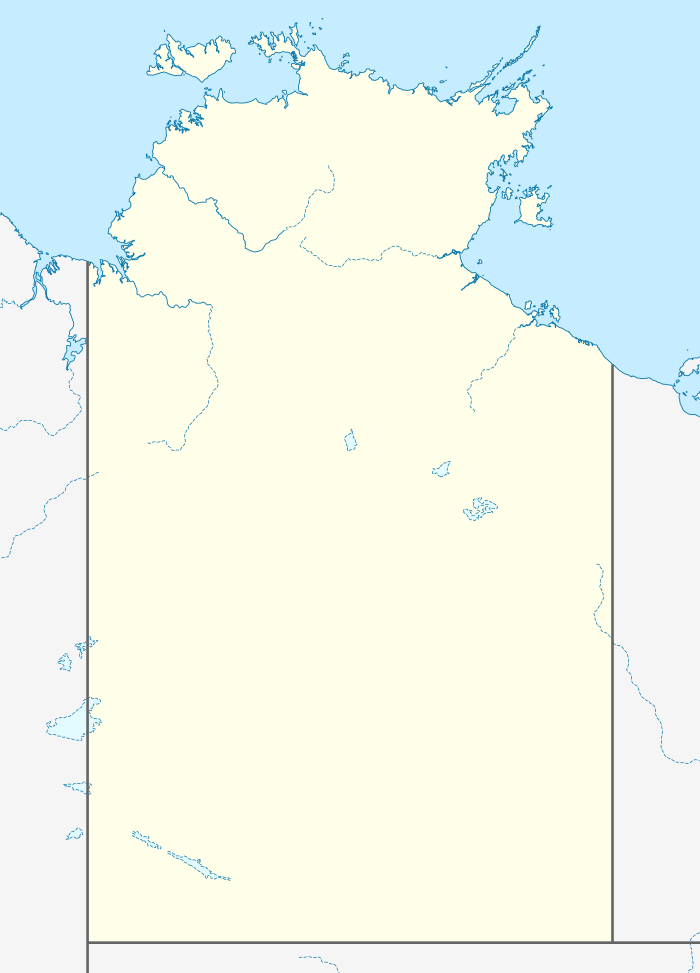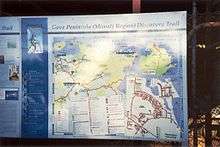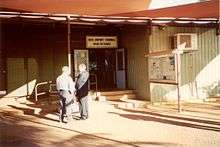Nhulunbuy
| Nhulunbuy Northern Territory | |||||||
|---|---|---|---|---|---|---|---|
 Nhulunbuy | |||||||
| Coordinates | 12°10′57″S 136°46′55″E / 12.18250°S 136.78194°ECoordinates: 12°10′57″S 136°46′55″E / 12.18250°S 136.78194°E | ||||||
| Population | 3,933 (2011 census)[1] | ||||||
| • Density | 552.4/km2 (1,430.7/sq mi) | ||||||
| Postcode(s) | 0881, 0880 | ||||||
| Elevation | 20 m (66 ft) | ||||||
| Area | 7.12 km2 (2.7 sq mi) | ||||||
| Location | |||||||
| Territory electorate(s) | Nhulunbuy | ||||||
| Federal Division(s) | Lingiari | ||||||
| |||||||


Nhulunbuy is a township that was created on the Gove Peninsula in the Northern Territory of Australia when a bauxite mine and deep water port were established nearby in the late 1960s, followed by an alumina refinery.[2] At the 2011 census, Nhulunbuy had a population of 3,933 with a median age of 32.[1] The closure of the alumina refinery in May 2014 resulted in 1,100 workers being redeployed or made redundant, substantially reducing this population.[3]
History
This area in Northeast Arnhem Land has been home to the Yolngu Aboriginal people for at least 40,000 years.
Matthew Flinders, in his circumnavigation of Australia in 1803, met the Macassan trading fleet near present-day Nhulunbuy, an encounter that led to the establishment of settlements on Melville Island and the Coburg Peninsula. A beach close to the township is named Macassan Beach in honour of this encounter.
In 1963, a Federal government decision excised part of the land for a bauxite mine to be operated by the North Australian Bauxite and Alumina Company (Nabalco). The Yolngu aborigines at Yirrkala were strongly opposed, and forwarded a bark petition to the Australian House of Representatives, which attracted national and international attention and which now hangs in Parliament House, Canberra.
The town of Nhulunbuy was then established, housing the workers and their families, who were employed by the Swiss Aluminium company. The mine is now owned by Rio Tinto who acquired Alcan in 2007. At one stage there were over 100 different nationalities present. During the 1970s the population rose to approximately 3,500 with 1,000 students at the combined primary and high school. A new high school was opened in 1981.
Permits are required to drive to Nhulunbuy — over 700 km of unsealed roads — so most supplies and visitors are brought by air to Gove Airport or by sea.
James Strong, who went on to be the CEO of Qantas, lived in the town at one stage when he was the head of the mine and port operations. Geoff Dixon, Strong's successor at Qantas, was also an employee.
Nhulunbuy is only 20 km from the Indigenous community of Yirrkala, famous for its Aboriginal art.
For the purposes of granting tax rebates to residents of isolated areas as per Section 79A(3F) of the Income Tax Assessment Act 1936, the census population of Nhulunbuy is taken to be less than 2,500).[4]
Education
In 1999, the first classes of the Nhulunbuy Christian College (formerly known as Nhulunbuy Christian School) were held at the local TAFE centre, and in 2001 the first building of the new school was completed. In 2007 the NCC Middle School was opened and in 2008 the combined year 8/9 Class was first established.
Refinery closure
On 29 November 2013 Rio Tinto announced the closure of the alumina refinery (but not the bauxite mine) by July 2014 with the loss of 1,100 jobs, or almost 25% of the town's population.[3][5] The refinery ceased production in May 2014.[6]
Nhulunbuy's population had already dropped by mid 2014, with some of the workforce retained to monitor the shutdown and survey holding ponds full of toxic compounds, but most will be gone by January 2015.[2][2] A range of measures were announced to support the town and its former workers through the closure and the following three years, but locals anticipate further cuts to services since the school, hospital, power plant and flights were backed by Rio Tinto.[7] The closure of the refinery also left flights on the Darwin-Nhulunbuy route to fall to around 50 to 60 per cent full, causing Qantas to suspend flights on the route from August 17.[8]
Climate
| Climate data for Nhulunbuy | |||||||||||||
|---|---|---|---|---|---|---|---|---|---|---|---|---|---|
| Month | Jan | Feb | Mar | Apr | May | Jun | Jul | Aug | Sep | Oct | Nov | Dec | Year |
| Record high °C (°F) | 35.7 (96.3) |
35.6 (96.1) |
35.7 (96.3) |
35.6 (96.1) |
34.0 (93.2) |
32.3 (90.1) |
31.2 (88.2) |
33.4 (92.1) |
34.6 (94.3) |
37.8 (100) |
37.3 (99.1) |
35.3 (95.5) |
37.8 (100) |
| Average high °C (°F) | 32.0 (89.6) |
31.7 (89.1) |
31.5 (88.7) |
31.5 (88.7) |
30.5 (86.9) |
29.5 (85.1) |
28.6 (83.5) |
29.0 (84.2) |
29.8 (85.6) |
30.9 (87.6) |
31.9 (89.4) |
32.4 (90.3) |
30.8 (87.4) |
| Average low °C (°F) | 25.5 (77.9) |
25.2 (77.4) |
24.9 (76.8) |
24.0 (75.2) |
23.2 (73.8) |
21.5 (70.7) |
20.5 (68.9) |
19.9 (67.8) |
21.1 (70) |
22.9 (73.2) |
25.1 (77.2) |
25.9 (78.6) |
23.3 (73.9) |
| Record low °C (°F) | 20.5 (68.9) |
22.0 (71.6) |
17.2 (63) |
20.5 (68.9) |
17.3 (63.1) |
15.5 (59.9) |
14.6 (58.3) |
14.0 (57.2) |
16.3 (61.3) |
15.1 (59.2) |
20.0 (68) |
21.2 (70.2) |
14.0 (57.2) |
| Average rainfall mm (inches) | 233.9 (9.209) |
241.7 (9.516) |
260.6 (10.26) |
237.1 (9.335) |
83.9 (3.303) |
17.8 (0.701) |
13.3 (0.524) |
4.1 (0.161) |
4.2 (0.165) |
12.0 (0.472) |
27.0 (1.063) |
189.9 (7.476) |
1,305.3 (51.39) |
| Average rainy days | 15.1 | 15.6 | 15.5 | 12.5 | 8.9 | 5.7 | 4.4 | 2.2 | 1.2 | 1.6 | 2.7 | 9.7 | 95.1 |
| Source: [9] | |||||||||||||
References
- 1 2 http://www.censusdata.abs.gov.au/census_services/getproduct/census/2011/quickstat/710252409?opendocument&navpos=220
- 1 2 3 http://www.theguardian.com/world/2014/aug/11/-sp-boom-to-dust-uncertain-future-for-town-run-by-rio-tinto
- 1 2 Perry, Juliet (21 October 2014). "Voices from Gove: Can a mining town survive a shutdown?". BBC News. Retrieved 22 October 2014.
- ↑ "INCOME TAX ASSESSMENT ACT 1936 - SECT 79A". Australian Government. Retrieved 11 January 2015.
- ↑ McGrath, Pat (29 November 2013). "About 1,100 jobs cut as Rio Tinto suspends production at Gove alumina refinery in the Northern Territory". ABC Online. Retrieved 12 Feb 2014.
- ↑ "Rio Tinto delivers another strong quarterly production performance" (PDF). Rio Tinto. 15 October 2014. Retrieved 23 May 2015.
- ↑ McGrath, Pat (29 November 2013). "Rio Tinto reveals rescue package for future of Nhulunbuy after alumina refinery closure". ABC Online. Retrieved 12 Feb 2014.
- ↑ Tsang, Daniel (7 August 2014). "Qantas faces defining moment". Aspire Aviation. Retrieved 21 August 2014.
- ↑ "Nhulunbuy DTW". Climate statistics for Australian locations. Bureau of Meteorology. Retrieved 26 November 2011.
External links
- Alcan History of Region
- Lirrwi Tourism Organisation
- Gove Online — Information about Nhulunbuy and the Gove Peninsula
- Nhulunbuy Corporation manages the township of Nhulunbuy